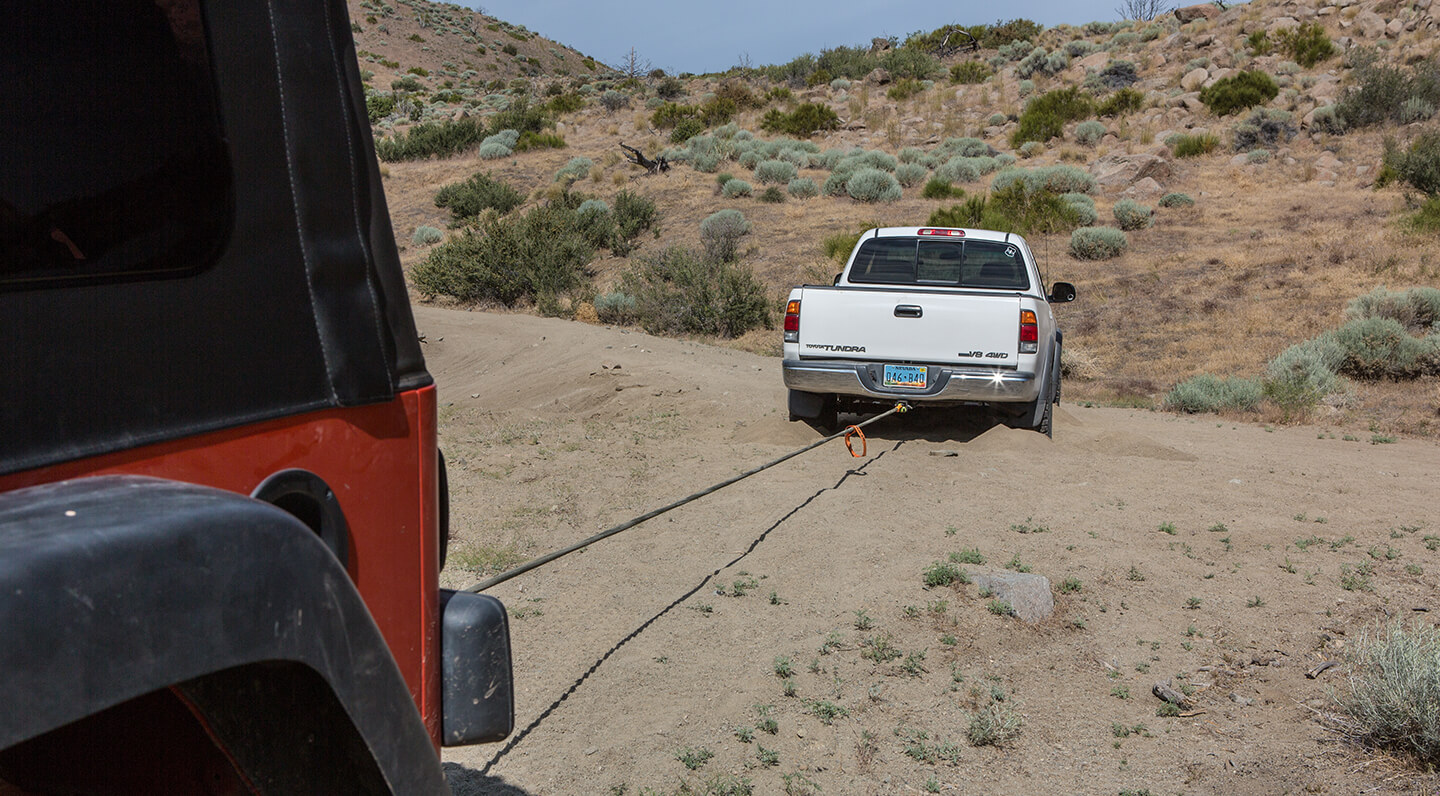
How To Use And Choose A Recovery Strap
We often talk about the benefits of adding a winch to your vehicle. They are a valuable piece of equipment that can get you out of situations where nothing else will help. For most recovery situations, a quality snatch strap will get the job done. Straps are not only less expensive, but they also don’t require any installation, weigh next to nothing, and are easy to use. In the rocks where you might need to pull up a rock face, or precisely move a vehicle, a winch is a better choice. In most circumstances, though, from sand to snow to mud, the energy from a snatch strap is a better choice for recovery.

A kinetic rope stretches during use. This stretch helps to take the shock load off of both vehicles. And, the stretch also aids in recovery by adding energy to yank the vehicle free as it returns to its original length.
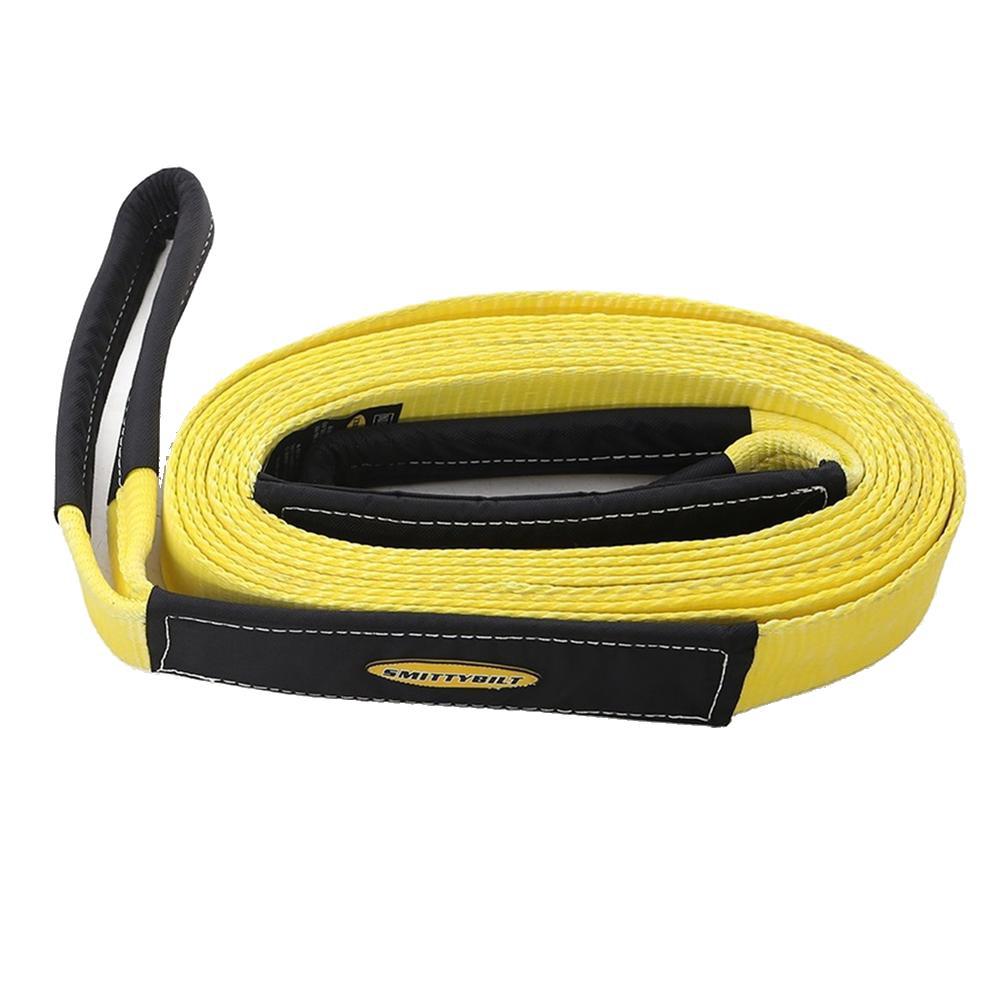
Kinetic Straps and Snatch Straps
There are a lot of terms to describe straps: snatch straps, kinetic ropes, winch straps, tree savers, tow straps, and more. Some are interchangeable, while others have specific uses. Ropes and straps refer to the shape as ropes are round and straps are flat. A Bubba Rope and an ARB recovery strap may look different, but they both perform the same task. Snatch straps and kinetic straps are terms that describe the same thing, a strap that stretches when under a load. The stretch allows the vehicle performing the recovery to get a running start. That energy extends the rope and slowly brings the recovering vehicle to a stop. Then the energy transfers to the stuck vehicle, which is smoothly set free as the rope or strap contracts back to its original length.
Tow Straps
A traditional tow strap is a piece of recovery gear made to help pull another vehicle, not extract it. Tow straps, winch extensions, and tree savers do not stretch. A tow strap is useful for pulling a disabled vehicle. These straps tend to be relatively inexpensive and resist abrasion should they drag along the ground. The least expensive tow straps have hooks at the end, which we do not recommend. They can potentially break and become deadly projectiles if they take a shock load higher than their working limit.
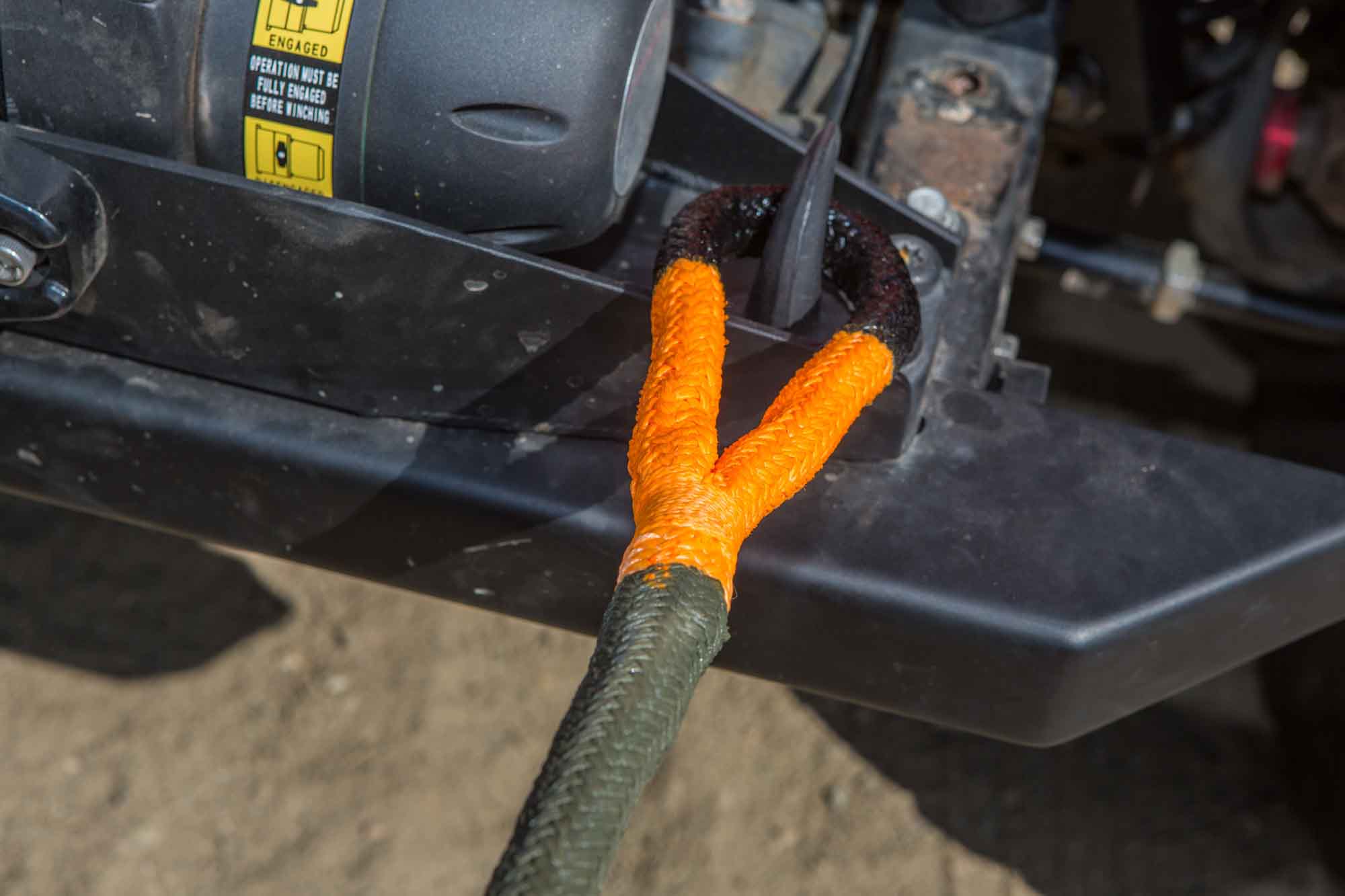
If your vehicle has open tow hooks, no additional equipment is required to attach a recovery strap. This is fairly common on Jeeps, but less so on trucks and SUVs where the front frame horns are not exposed. The downside to open hooks is that the strap can fall off if it is not under tension.

Receiver hitches can be found on the back of most trucks and make good recovery points. Never use a tow ball for recovery. Instead remove the ball from the receiver and attach the strap with the hitch pin. If the strap is too large to fit in the receiver, a soft shackle or receiver clevis mount can come in handy.
Winch Extensions and Tree Savers
Winch line extensions are similar to tow straps because they do not stretch. Most winches have 100 feet of cable, and you need to keep at least a few wraps of cable on the drum for safety. If there is nothing within 100 feet, an extension can be useful to get to that elusive tree or a vehicle on firm ground. Tree savers are short winch line extensions that can wrap around trees or rocks without damaging the environment or your winch line. Never hook a winch cable back on to itself, or you risk kinking or cutting the cable and compromising its strength.
Weight Ratings
Kinetic ropes and tow straps are available for everything from UTVs to full-size trucks. Tow straps are usually polypropylene or polyester. Both are materials that don’t stretch. In contrast, snatch straps are nylon, which can stretch up to 30% without being compromised. We recommend choosing a strap that is rated at least four times the weight of your vehicle when fully loaded. This will account for the extra force necessary to overcome being stuck and still be safely within the working load limit.
Not sure what your vehicle weighs? Most two-door Jeeps and small SUVs are in the 4,000-pound range. Four-door Wranglers with winches, armor, and one-ton axles can tip the scales at 7,000 pounds. Half-ton trucks and SUVs are similar in weight, with 3/4 and one-ton diesel trucks weighing closer to 8,000 pounds.
Note that the ratings are not linear. Smittybilt’s 1-inch kinetic rope rates at 30,000 pounds. But the 1 1/2-inch kinetic rope rates at 60,000 pounds even though it is not twice the diameter. The larger the rope, the more significant the safety rating factor, but you can go too big. Since snatch straps stretch, going too big means it will be harder to stretch the strap when a load is applied. Larger ropes are also more difficult to use with smaller tow hooks, shackles, and receiver hitches.

Tree saver straps are inexpensive and hardly take up any space. They are useful not only with trees but around rocks and other objects as well. These straps are do not stretch. That is useful with rocks since they are less prone to get pulled under an edge than a snatch strap is.

Note how the Ford is in position to the Tundra to get a running start to pull the Toyota out. The Tundra transmission was put in neutral not to shock the drivetrain and then shifted into reverse when the truck started moving. Remember, to gradually accelerate as you pull a vehicle out so you don’t damage either vehicle.
How To Attach Your Strap
Straps should only attach to sturdy recovery points that rate as high as the strap you are using. These can include D-ring attachments on bumpers, frame-mounted tow hooks, and receiver hitches. If you have hooks, all that might be necessary is a strap with loops on its ends. Closed D-ring mounts will require using either a bow-type or soft shackle. Factory pickups and SUVs can be more of a challenge, particularly if they have unibody construction without a frame. You will probably have to get a little dirty crawling under the air dam of a stock SUV to find a suitable point to recover it from.
Equally important to how to attach a strap is how not to attach a strap. Never wrap a strap around suspension or steering components. These components could bend or take damage when the tow strap is under a load. A tow ball seems like a convenient recovery point, but if the ball breaks it essentially becomes a cannonball. It will cause serious harm to whatever happens to be in its path.
Similarly, never attach a strap to a winch hook, as shock loading the winch could damage its internals. And, it might seem obvious, but don’t wrap a tow strap around a bumper. We have seen people tear factory bumpers in half thinking they could take the load.
How To Perform A Recovery
One of the biggest mistakes we see people make when they get stuck is being in a hurry. Unless you are on the edge of a cliff or in quicksand, slower is always better. Take your time to ensure that you correctly attach the strap to both vehicles. Ensure that everyone is a safe distance away should something go wrong. It is best to pull downhill whenever possible, whether that is forward or backward. Map out where you are going to go and ensure that there is plenty of room to get moving and get both vehicles to solid ground.
The vehicle performing the recovery will want to get a running start to stretch the snatch strap. You don’t have to be too aggressive. Think of it like taking off from a stoplight and keep accelerating as the other vehicle starts moving. A driver should be in vehicle being recovered to help with the recovery. And to help determine when it can move again under its own power. Communication between both drivers is critical. We recommend having radios, using hand signals that have been agreed upon ahead of time, or a third person outside of the vehicles to coordinate the recovery.
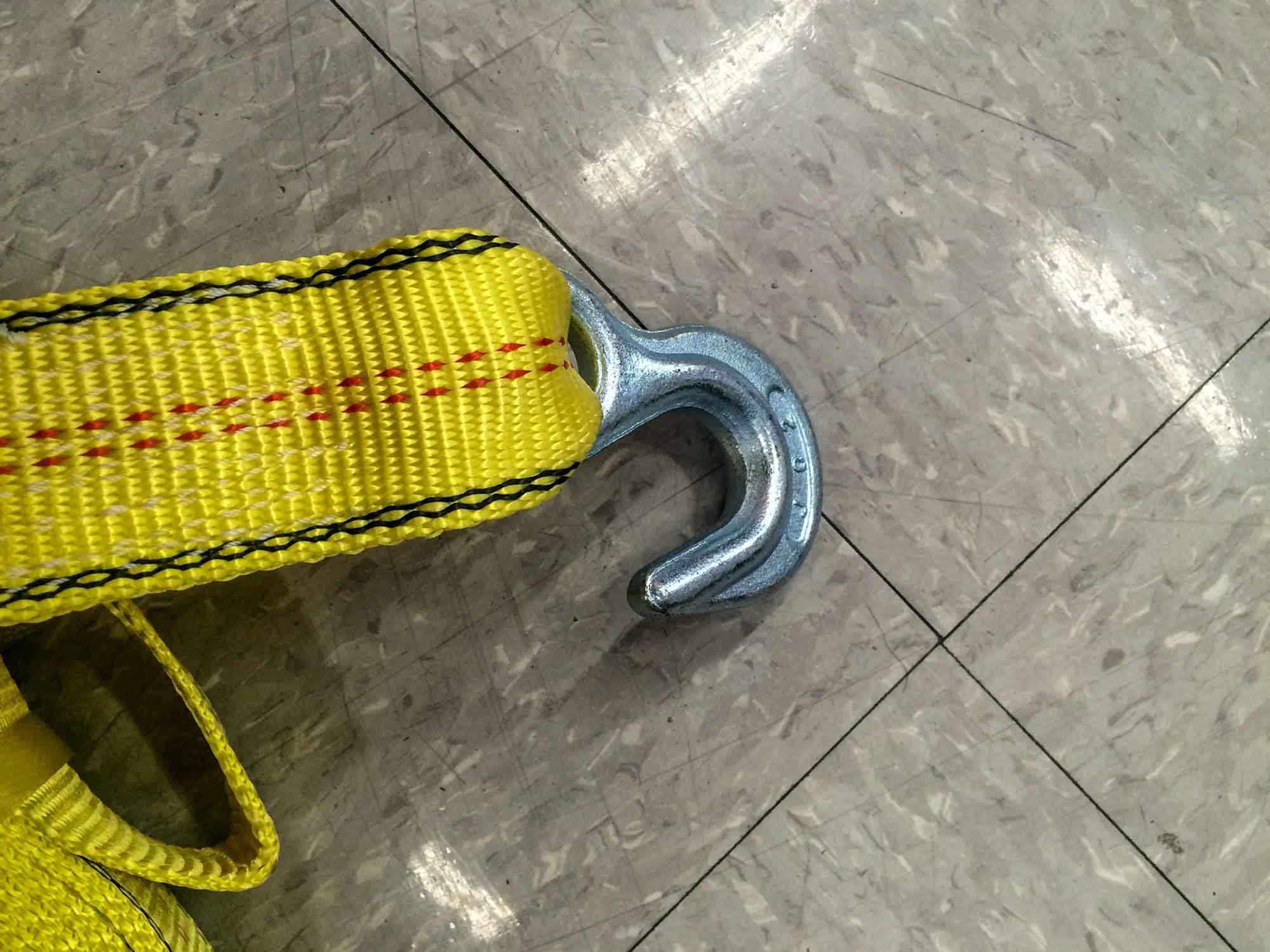
You might want to buy a cheap tow strap from an auto parts store or big box store. Don’t! You never want to get a strap with hooks on the ends. While these might seem convenient to attach to slots in unibody chassis vehicles, they also are prone to breaking when under a sudden load. The hook then becomes a projectile, traveling through whatever happens to be in its path.
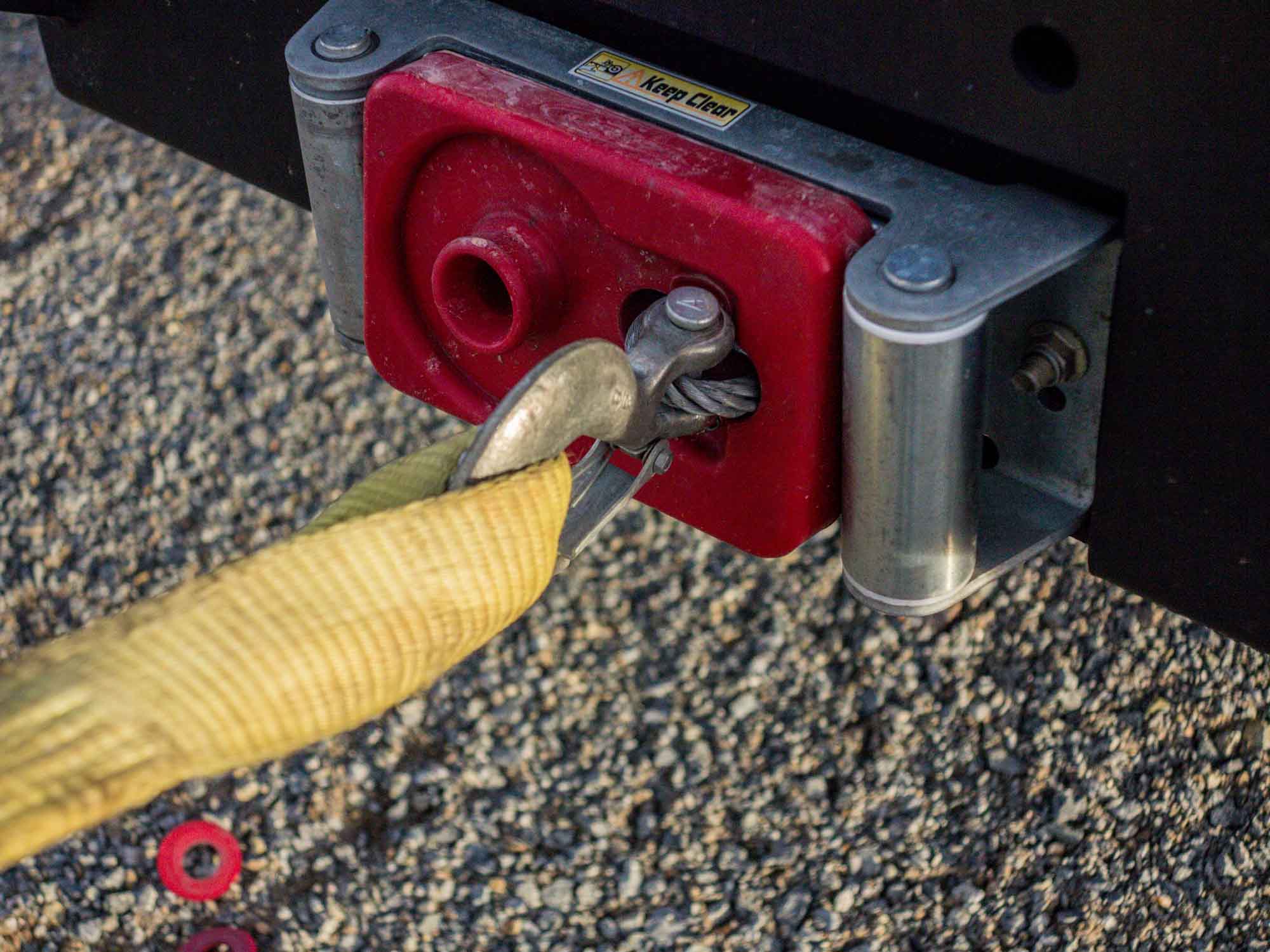
You don’t want to pull a vehicle by the winch cable, regardless of whether you are using a snatch strap or a tow strap. Pulling from the winch cable can shock load the gears and other internal winch components and leave them in a pile at the bottom of your winch housing. Use frame-mounted recovery points whenever possible as they are the strongest.
How To Tow A Vehicle
Towing a vehicle requires even more coordination between the two drivers, particularly if you are traveling at a higher rate of speed. The driver of the vehicle being towed needs to pay close attention to what is happening and anticipate any stops. The rear vehicle will need to do the bulk of the stopping to keep the tow strap tight. Since tow straps have very little give, this will minimize slack and prevent harsh jarring when the tow vehicle starts accelerating. It also reduces the chance that the tow strap drags on the ground, or even gets run over. You can tow with a snatch strap as well, but the same rules apply to its use. Regardless of whether you carry one strap or multiple ones, make sure and add this equipment to your recovery gear. Remember to take your time and be safe when it comes time to use them.




2